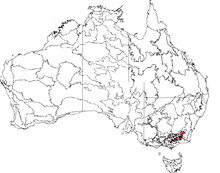Ngarigo
| Ngarigo people | |
|---|---|
| aka: Ngarigo (language name), Ngarego, Ngarago, Garego, Currak-da-bidgee, Ngarigu, Ngarrugu, Ngarroogoo, Murring ("men"), Bemeringal (by coastal tribes "mountain man"), Guramal, Gurmal (by Wiradjuri), Bradjerak (by southern coastal tribes), Bombala tribe, Menero tribe, and Cooma tribe (AIATSIS), nd (SIL) | |

|
|
| Hierarchy | |
| Language family: | Pama–Nyungan |
| Language branch: | Yuin–Kuric |
| Language group: | Yora |
| Group dialects: | Ngarigu |
| Area | |
| Location: | Monaro and Australian Alpine regions of New South Wales and Victoria |
| Rivers | |
| Urban areas |
|
The Ngarigo people are some of the Indigenous inhabitants living in South East Australia, and whose traditional lands extended from Canberra to Cooma, on the Monaro and Limestone Plains.
According to anthropologist Norman Tindale in his 1974 catalogue of Australian Aboriginal people groups, the specific areas lands of the Ngarigo are:
Monaro tableland north to Queanbeyan; Bombala River from near Delegate to Nimmitabel; west to divide of the Australian Alps.
However, as stated by the South Australia Museum where his maps are archived, much of the data relating to Aboriginal language group distribution and definition has undergone revision since 1974.
Recent linguistic research showed the northern boundary of the Ngarigu to be north of the present Australia Capital Territory, while the southern boundary of the Ngarigo people extends to the Australian Alps. Further south various dialects of Ngarigu are spoken by other tribes. However, as concluded in the 2013 ACT Government report "Our Kin Our Country", due to lack of accurate contemporary records the exact boundaries are uncertain.
The Ngarigo/Ngarmal are an Aboriginal group whose traditional lands lie in the Monaro and Australian Alpine regions of New South Wales and Victoria, and the Canberra and Queanbeayan area.
With their hunting areas being taken over by European settlers running sheep, most Nyamudy/Namadgi people gradually left the area. The population also decreased due to the spread of diseases introduced by the Europeans, such as smallpox, syphilis, influenza, measles and tuberculosis. Thus, all that was left were mixed race people working either as labourers or domestic servants. Many people were moved to New South Wales government settlements, such as at Yass. By 1880 there were no full blood Aboriginal people living in the Canberra area and their long-standing traditions went into hibernation.
...
Wikipedia
